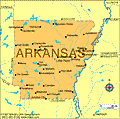Read this profile of Arkansas to learn about the state's history, points of interest, and government. Also find interesting facts about each state, including the state's motto, symbols, and when it entered the union.
 History Spaniard Hernando de Soto was among the early European explorers to visit the territory in the mid-16th century, but it was a Frenchman, Henri de Tonti, who in 1686 founded the first permanent white settlement—the Arkansas Post. In 1803 the area was acquired by the U.S. as part of the Louisiana Purchase. Part of the Territory of Missouri from 1812, the area became a separate entity in 1819 after the first large wave of settlers arrived. The next several decades were marked by the development of the cotton industry and the spread of the Southern plantation system west into Arkansas. Arkansas joined the Confederacy in 1861, but from 1863 the northern part of the state was occupied by Union troops. Food products are the state's largest employing sector, with lumber and wood products a close second. Arkansas is also a leader in the production of cotton, rice, and soybeans. It also has the country's only active diamond mine; located near Murfreesboro, it is operated as a tourist attraction. Hot Springs National Park and Buffalo National River in the Ozarks are major state attractions. Blanchard Springs Caverns, the Historic Arkansas Museum at Little Rock, the William J. Clinton Birthplace in Hope, and the Arkansas Folk Center in Mountain View are also of interest. |




